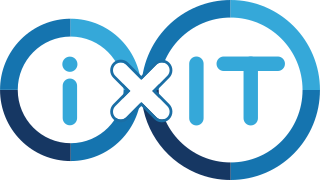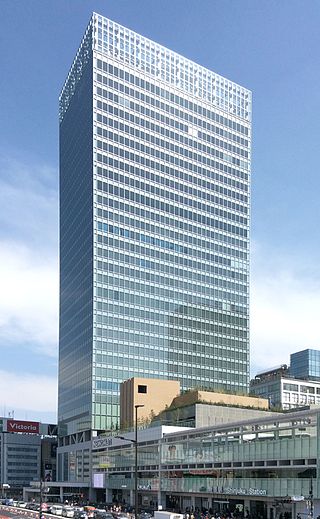Turbolinux is a discontinued Japanese Linux distribution targeting Asian users.

The PC-8800 series, commonly shortened to PC-88, are a brand of Zilog Z80-based 8-bit home computers released by Nippon Electric Company (NEC) in 1981 and primarily sold in Japan.

The NEC PC-100 was a Japanese home computer available on October 13, 1983. It operated on 8086 CPU 7 MHz, 128KB RAM, 128KB VRAM, a Japanese language capable keyboard and a two button mouse. It had three models and its color monitor, PC-KD651, which could be used vertically or horizontally, had the price tag of 198,000 yen. Its biggest advantage over other computers of that time was its high graphical capability of 720 by 512 with a selection of 16 color out of 512 color available on its high end model30. Its OS was MS-DOS and was also equipped with a spreadsheet program Maruchipuran (Multiplan) and a text editor JS-WORD as well as the game Lode Runner.

EMI Music Japan Inc., formerly Toshiba EMI, was one of Japan's leading music companies. It became a wholly owned subsidiary of British music company EMI Group Ltd. on June 30, 2007, after Toshiba sold off its previous 45% stake. Its CEO and president was Kazuhiko Koike. When EMI Music Japan was trading as Toshiba-EMI, it was involved with the production of anime. On April 1, 2013, the company became defunct, following its absorption into Universal Music Japan as a sublabel under the name EMI Records Japan.

Microsoft Japan Co., Ltd. is a Japanese subsidiary of Microsoft headquartered in Minato, Tokyo. It develops both hardware and software technologies for consumers and business partners.
Cambridge Technology Partners is a Japan-based multinational professional services company that specializes in business and IT consulting.
Plala is a major Japanese Internet service provider operated by NTT Plala Inc. It was established in 1995 and focuses on consumer internet services. Its major stockholder is NTT Communications Corp. The company's name was changed to "NTT Plala" from "Plala" on March 1, 2008.

iXIT Corporation, formerly known as Index Corporation, is a Japanese corporate information and communications technology company owned by Sawada Holdings.
Mitsubishi Research Institute DCS (三菱総研DCS), often simply called DCS, for Diamond Computer Service, its former name, is the system integrator of Mitsubishi UFJ Financial Group (MUFG), jointly owned by Mitsubishi Research Institute, Inc. (MRI) and MUFG. It was established in 1970 from the IT service department of Mitsubishi Bank, listed in the First Floor of Tokyo Stock Exchange in 2001, but was delisted in 2004. It now employs about 1800 people.

PFU Limited is a Japanese information technology company jointly owned by Ricoh and Fujitsu. The company was formed by the merger of Panafacom and USAC Electronic Industrial in 1987.
The Innovation Network Corporation of Japan (INCJ), headquartered in Tokyo, is a public-private partnership between the Japanese government and 19 major corporations.

Line Corporation was a Japanese Internet company. It was a subsidiary of Z Holdings, a joint venture between SoftBank Group and Naver Corporation. It was established in 2000 as the Japanese subsidiary of South Korean NHN Corporation's online game community site Hangame, under the name Hangame Japan. In 2003, it was renamed NHN Japan and in 2013, it was rebranded as Line Corporation.

The Ainokaze Toyama Railway is a Japanese third-sector railway operating company established in 2012 to operate passenger railway services on the section of the JR West Hokuriku Main Line within Toyama Prefecture when it was separated from the JR West network in March 2015, coinciding with the opening of the Hokuriku Shinkansen extension from Nagano to Kanazawa. The company was founded on 24 July 2012, and has its headquarters in Toyama in Toyama Prefecture.

Seibu Holdings, Inc. is a Japanese holding company that primarily owns Seibu Railway, Prince Hotels, and Seibu Bus and its subsidiaries, which are collectively known as the Seibu Group. In total, fifty-three companies across the world are affiliated with the Seibu Group. The company was formed in 2006 to restructure the group after it had come to light in 2004 that the predecessor to Seibu Holdings, Kokudo, had falsified the ownership of its shares in Seibu Railway for over forty years.
Vernalossom Co., Ltd., formerly AKS Co., Ltd., is a Japanese talent agency headquartered in Tokyo, Japan. The company is involved in various entertainment-related industries, including music, film and merchandise production.

Kadokawa Corporation (KADOKAWA) (Japanese: 株式会社KADOKAWA, Hepburn: Kabushiki-gaisha Kadokawa), formerly Kadokawa Dwango Corporation, is a Japanese media conglomerate that was created as a result of the merger of the original Kadokawa Corporation and Dwango Co., Ltd. on October 1, 2014.
Space Shower Music is a Japanese record label and talent agency owned by Space Shower Network, best known as the operator of Space Shower TV.
NMKV Co., Ltd. is a joint venture company between Nissan Motor Co., Ltd. and Mitsubishi Motors in the Japanese market to design, develop, and manufacture kei cars under Nissan and Mitsubishi brands. The company currently produces Mitsubishi eK, Nissan Dayz, Mitsubishi eK Space and Nissan Roox for the domestic market. NMKV stands for Nissan Mitsubishi Kei Vehicle. Despite that, the abbreviation was never announced officially by the company.
Dynabook Inc., formerly Toshiba Client Solutions Co., Ltd., is a Japanese personal computer manufacturer owned by Sharp Corporation; it was owned by, and branded as, Toshiba from 1958 to 2018. It claims its Toshiba T1100, launched in 1985, as the first mass-market laptop PC. Toshiba had used "DynaBook" or "dynabook" as a sub-brand since 1989, but Dynabook became the worldwide brand in 2019.
Preferred Networks Inc. is a Japanese startup focused on the research and development of deep learning for IoT applications. The company was spun off from Preferred Infrastructure (PFI), founded by Toru Nishikawa, Daisuke Okanohara, and others on March 26, 2014.











